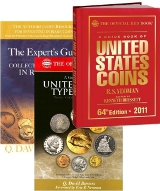

Tips to Valuing Your Coins with Price Guides

Here are 4 things you need to know before you set a value to your coin collection using price guides.
You're sitting at your desk, looking at one of your most prized possessions from your coin collection and you want to know how much it’s worth. You pick up a recent price guide laying nearby and quickly look up your coin's value. Pretty simple – right?
Unfortunately it’s not so simple.
Grade
The prices listed in price guides are based on a coin being in a certain grade or condition. You need to know both the grade of your coin and the grade the guide is using before you can determine the price. Most price guides will have a section that explains what grade the guide is using for its prices and how to determine the grade of your coin.
For example, two beginning collectors with the same circulated coin might assume both coins would have the same price, but in reality each coin may have a different price based on its condition. The coin in better condition will usually sell for a premium over the other coin. Once you know which coin the price reflects, you can make an adjustment for the price for the other coin. Sometimes the price guide will help you on how to do this, but not always.
Market Conditions
One negative aspect of printed price guides is that they can quickly become outdated due to changing market conditions. For example, a new 2011 price guide would probably have been released during the summer in 2010. Even then, a few months have passed since the prices were compiled. How accurate are they when you actually use the guide?
Plus keep in mind it’s not just rarity and condition that determines the price for your coin, it’s also demand or popularity. Is your coin still popular? For example, popularity among collectors may switch from commemorative coins to Buffalo nickels causing an increase in prices for the latter at the expense of price decreases for the former.
Retail Prices
Finally, those prices listed in the price guides are retail prices with a few exceptions such as the popular Blue Book. They are not the value of your coin. They are how much you would pay to purchase the coin from a dealer. The value of your coin is how much the dealer is willing to pay you – and that may be considerably less.
Dealers are just like any other retailer and need to make a profit in order to stay in business. So once you’ve determined a retail price for your coin, you need to subtract an amount that you think is a fair representation of what a dealer’s markup would be. For high value coins, this could be from 5% to 15%. For more common coins, this could be 25 to 50% or even much higher.
Insuring Your Collection
If you are insuring your collection, the retail price of your coins is the amount to insure. The retail price is what it would cost you to replace your collection in the event that something unthinkable happened and you lost your collection.
